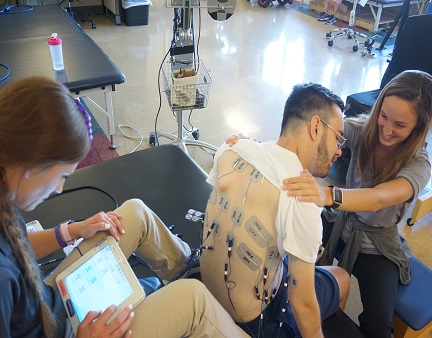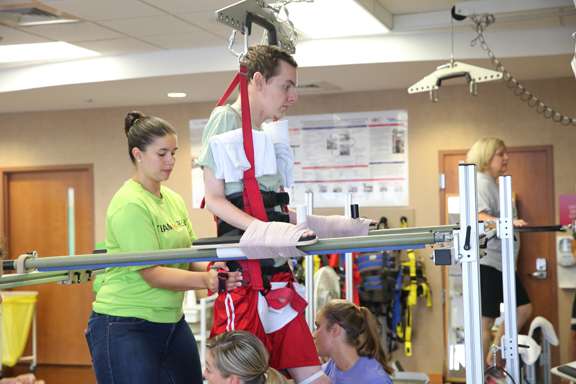Scientific Director

Charles Hubscher, PhD
|
|
|
The Team
|
Research
Scientist

Siqi Wang, PhD
|
Core
Manager

Harley Ledbetter, BS
|
|
Research Intern

Youssef Bekhiet
|
Research Intern

Caden Maners
|
Research Intern

Arya Pallavarapu
|
C.O.R.E.
Comprehensive
Our team provides scientific and technical expertise necessary to study the mechanisms of respiratory-cardiovascular complications after spinal cord injury. Working in collaboration with multi-disciplinary researchers, clinicians, bioengineers, and other specialists, the main focus of our work is the development of effective therapeutic strategies to improve respiratory and cardiovascular deficits that develop after injury.
Objective
We design protocols using standard medical and research equipment to obtain objective assessments of Cardiovascular and Pulmonary functions. These assessments are essential to helping us better understand, improve and ultimately overcome dysfunction in these areas.
Cardiovascular Assessments
- Orthostatic Stress Test (CV-Cat): This test assesses the cardiovascular responses to postural changes. Beat-by-beat blood pressure, heart rate, cerebral blood flow, echocardiographic measures of the heart and vessels, pulse wave velocity, and respiratory kinematics are measured while participants lay on their backs and when the position is rapidly changed to the head up tilt position. During this test, before and after the position change, licensed personnel may also take blood samples from a catheter inserted into the antecubital vein to measure catecholamine levels.
- Ambulatory Blood Pressure and Heart Rate Monitoring (ABPM and BioRadio): Performed outside of the laboratory, heart rate and blood pressure are monitored with portable devices as the individual completes normal daily activities with a regular sleep schedule. Each participant is asked to complete a daily diary of any activity that may alter blood pressure or heart rate. The blood pressure is recorded at set intervals while heart rate is monitored continuously. Participants may also be given the Autonomic Dysfunction Following Spinal Cord Injury (ADFSCI) questionnaire that asks about their blood pressure stability and episodes of autonomic dysreflexia during their daily life.
- Cardiovascular and Respiratory Stimulation Configuration Mapping (CVsc-ES and RTsc-ES): These assessments are used for finding the optimal cardiovascular and respiratory epidural stimulation configurations to modulate arterial blood pressure and the motor control of breathing. These assessments may be done with recordings of muscle activity, blood pressure, heart rate, respiratory rate, and lung volume and airway pressure.
- Arterial pulse wave velocity (aPWV): Blood vessel properties are assessed using a pressure detection technique. The test is performed while the participant is laying down or in the head up tilt position. Pressure sensors are placed over the carotid and femoral artery pulse locations for 7-10 consecutive beats. The software calculates the mean velocity of the pulse waves and compares the values to a normative data set.
- Trans-Cranial Doppler: A special headset with ultrasound sensors that rest against the temples is placed on the participant to measure the blood flow in the middle cerebral and posterior cerebral arteries. This technique of measuring blood flow in the brain can be paired together with other assessments of cardiovascular, pulmonary, and cognitive function.
- Echocardiography: This assessment, utilizing Doppler Ultrasound, is used to assess the function of the heart.
- Vascular Ultrasound:This assessment, utilizing Doppler Ultrasound, is used to assess the function of the major blood vessels in the body.
- Immunological Blood Panel (IBP): For this test, two tablespoons of blood are drawn and analyzed to provide information about the individual’s immune system, the gene profile of the blood cells, as well as the number and type of blood cells in the sample.
- Cognitive Assessment Battery (CAB): This series of tests is used to assess various domains of cognitive function such as memory and verbal fluency. These tests may include remembering a list of words read out loud, identifying colors and shapes, looking for patterns, generating a list of words beginning with a certain letter, etc. During these tests blood pressure, heart rate, cerebral blood flow, respiratory rate and CO2 levels may be monitored.
Respiratory Assessments
- Pulmonary Function Test (PFT): Using spirometry and airway pressure measurements, each participant is asked to inhale and exhale though a mouth piece to acquire lung volume, airflow, and maximum airway pressure generation.
- Respiratory Motor Control Assessment (RMCA): Simultaneously with PFT, muscle activity in the neck, chest and abdomen is recorded using sensors placed over the belly of each respiratory muscle. Additionally, continuous beat-by-beat blood pressure, heart rate, and respiratory kinematics are recorded during the assessment.
- Aerobic Fitness Test (VO2Peak): Depending on individual’s functional ability, the participants must maintain up to 30 rpm’s on a seated elliptical machine with periodic increases in work load to determine the rate of oxygen consumption needed during maximal exercise. These oxygen levels are obtained from a facemask worn during the test that samples the exhaled air.
- Resting Metabolic Rate (RMR): Fasted individuals lay down on a bed while a plastic canopy hood is placed over their head. The canopy hood captures the exhaled air which is analyzed to estimate the daily caloric needs of the individual at rest.
Research-driven
We employ a “Discovery-to-Recovery” approach and work closely across disciplines to expand knowledge and bring innovative treatments to practice so that individuals with spinal cord injuries can experience their own personal Victory Over Paralysis. Our work is published in leading scientific journals and copies of our most recent articles are available here.
Evidence-based
The assessments we perform are leading to greater understanding of how we can use interventions such as Respiratory Training (RT); Locomotor Training (LT); Neuromuscular Electrical Stimulation (NMES); spinal cord Epidural Stimulation (scES); and Transcutaneous Electrical Spinal Cord Stimulation (TcESCS) to regain respiratory-cardiovascular function and improve quality-of-life for individuals with spinal cord injuries.

Innervation of the respiratory and cardiovascular systems.
|
Adult NeuroRecovery
Translational Cores
Metabolic, Neuromuscular, and Skeletal
Cardiovascular and Pulmonary
Studies
Movement Performance and Locomotor Recovery
Urogenital and Bowel
Neurophysiology
Engineering
Research Medical
Biostatistics, Outcomes, Database, and Communications
Finance and Administrative
Movement Performance and Locomotor Recovery Clinic
Investigators
|












